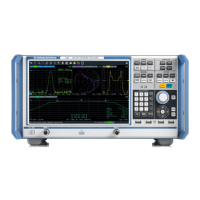Concepts and Features
R&S
®
ZNB/ZNBT
133User Manual 1173.9163.02 ─ 53
5.3.7 Stability Factors
The stability factors K, μ1 and μ2 are real functions of the (complex) S-parameters,
defined as follows:
||2
||||||1
:
2112
2
21122211
2
22
2
11
SS
SSSSSS
K
|||)(|
||1
:
2112211222111122
2
11
1
SSSSSSSS
S
|||)(|
||1
:
2112211222112211
2
22
2
SSSSSSSS
S
where denotes the complex conjugate of S.
Stability factors are calculated as functions of the frequency or another stimulus
parameter. They provide criteria for linear stability of two-ports such as amplifiers. A lin-
ear circuit is said to be unconditionally stable if no combination of passive source or
load can cause the circuit to oscillate.
●
The K-factor provides a necessary condition for unconditional stability: A circuit is
unconditionally stable if K>1 and an additional condition is met. The additional con-
dition can be tested with the stability factors μ
1
and μ
2
.
●
The μ
1
and μ
2
factors both provide a necessary and sufficient condition for uncondi-
tional stability: The conditions μ
1
>1 or μ
2
>1 are both equivalent to unconditional
stability. This means that μ
1
and μ
2
provide direct insight into the degree of stability
or potential instability of linear circuits.
References: Marion Lee Edwards and Jeffrey H. Sinsky, "A New Criterion for Linear 2-
Port Stability Using a Single Geometrically Derived Parameter", IEEE Trans. MTT, vol.
40, No. 12, pp. 2303-2311, Dec. 1992.
5.3.8 Delay, Aperture, Electrical Length
The group delay τ
g
represents the propagation time of wave through a device. τ
g
is a
real quantity and is calculated as the negative of the derivative of its phase response.
A non-dispersive DUT shows a linear phase response, which produces a constant
delay (a constant ratio of phase difference to frequency difference).
The group delay is defined as:
df
d
d
d
deg
rad
g
360
where
Φ
rad
, Φ
deg
= phase response in radians or degrees
ω = angular velocity in radians/s
Measurement Results

